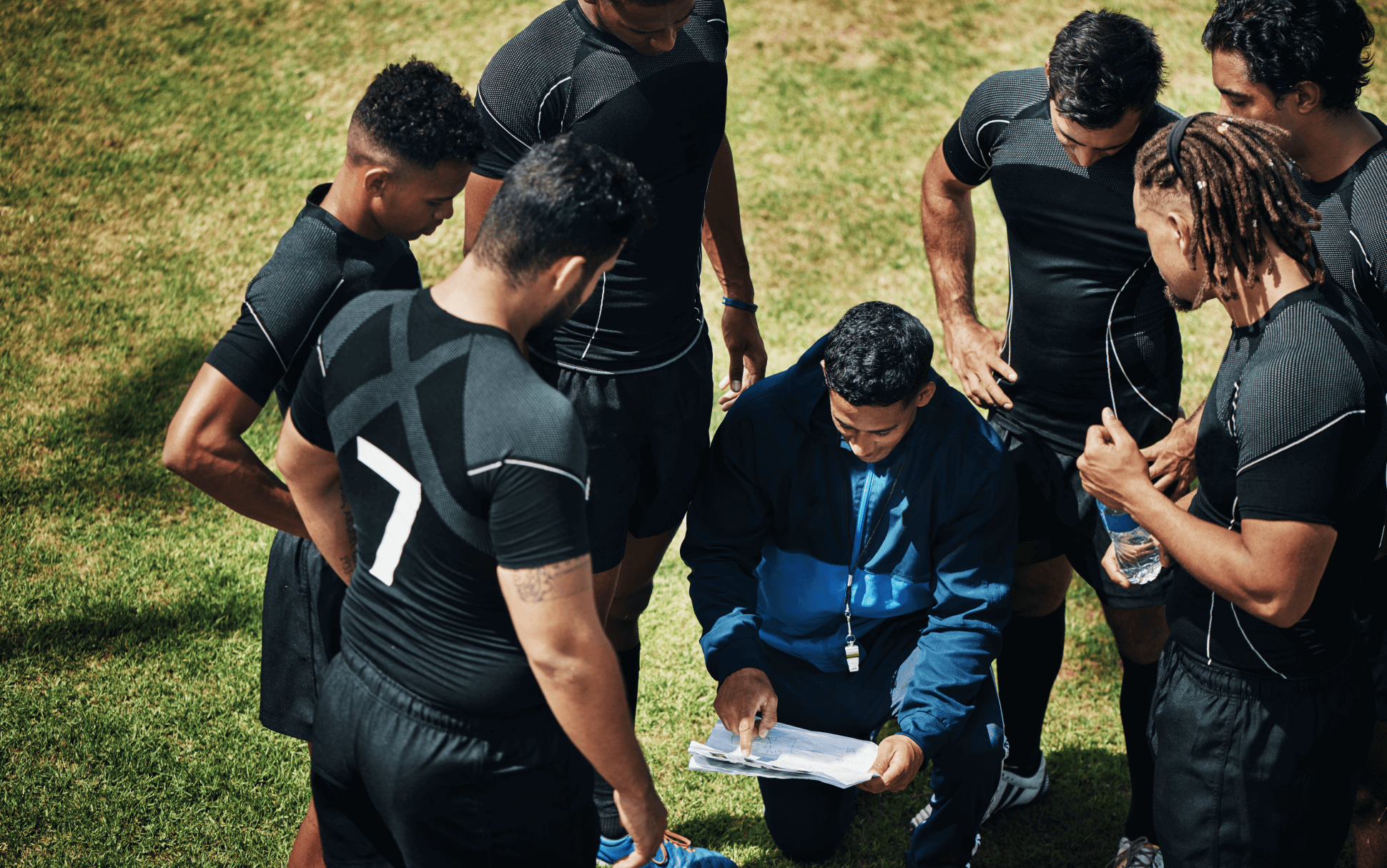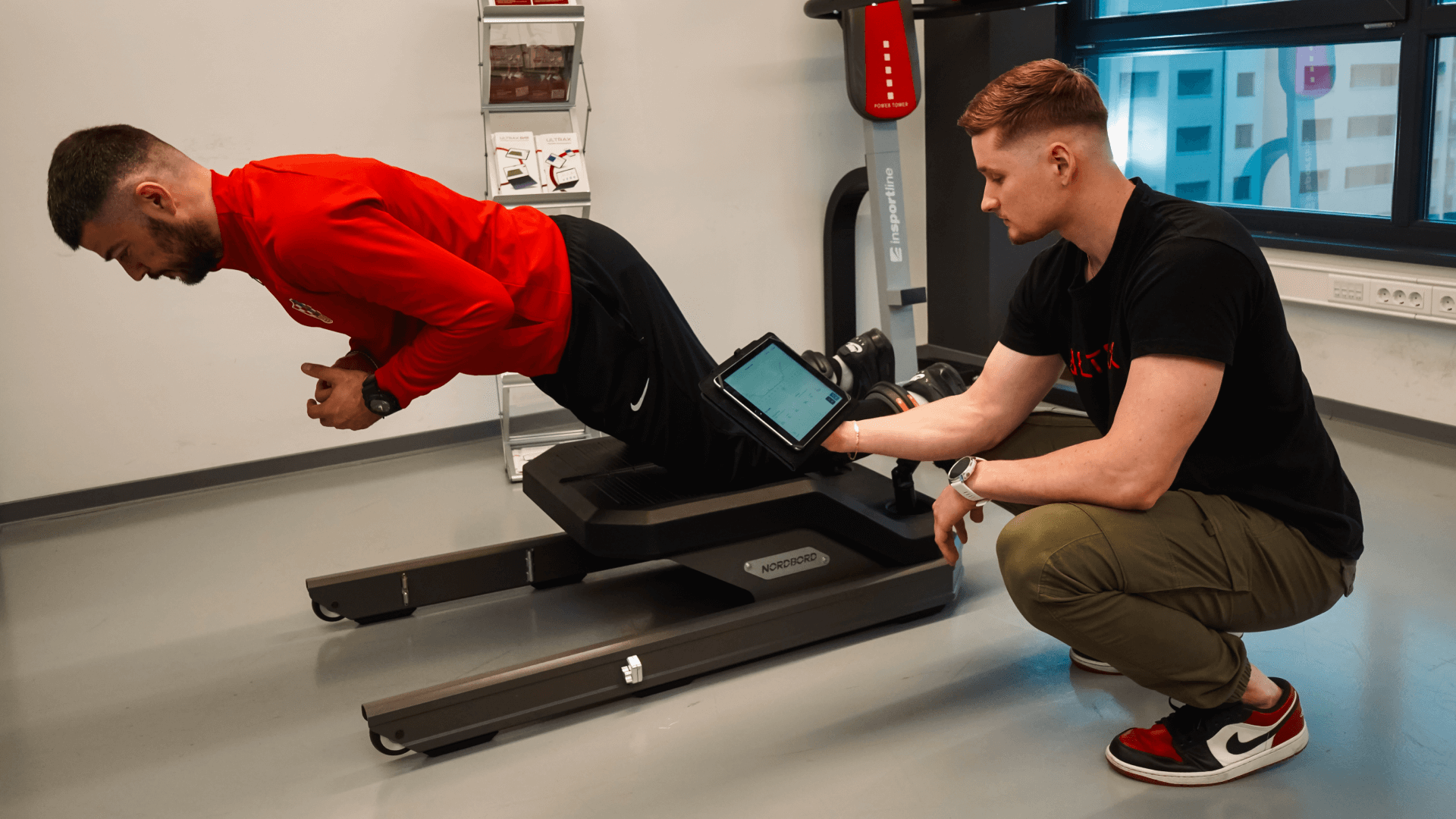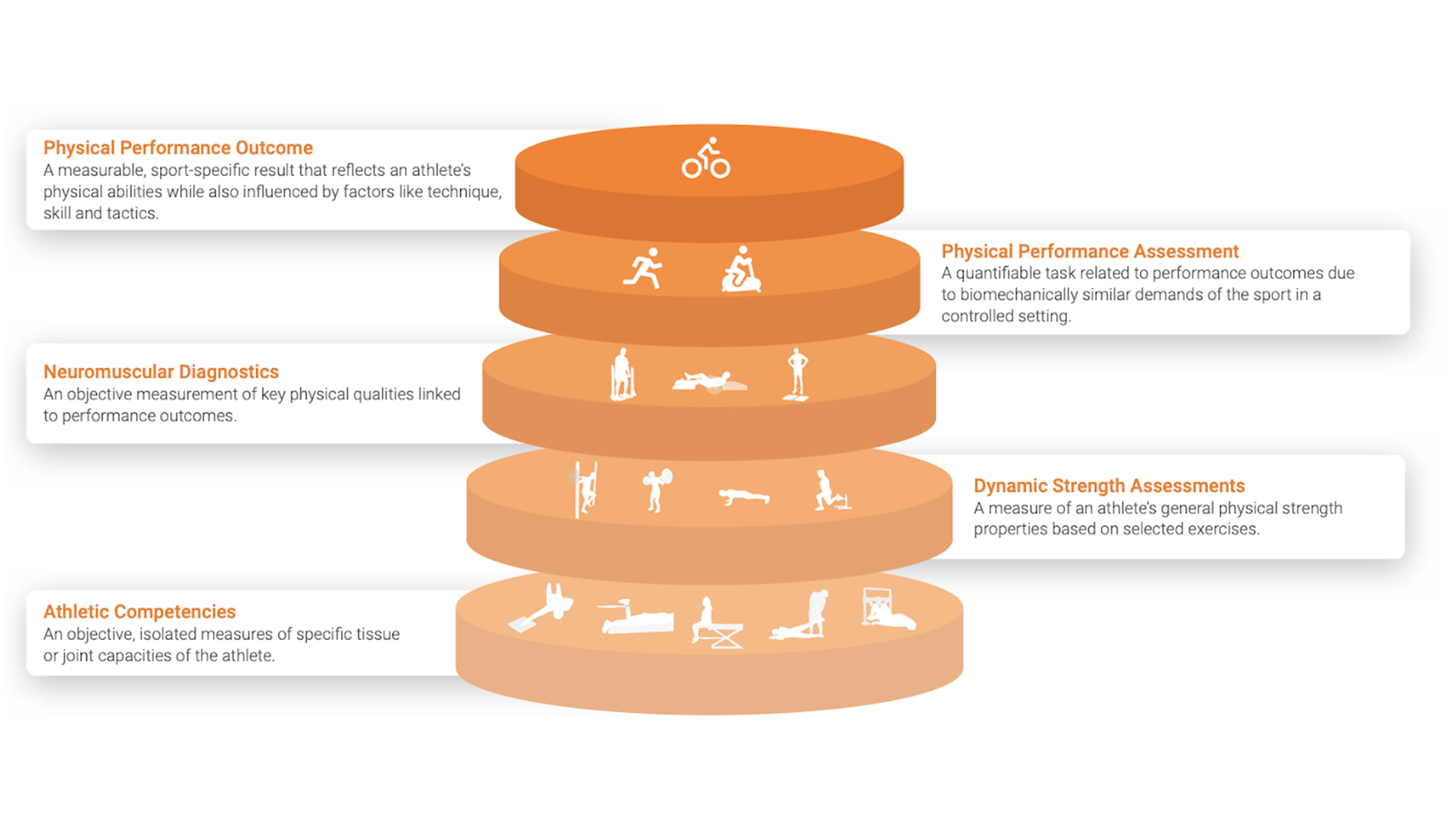In this article, we introduce a quadrant model that leverages two key force-time metrics from countermovement jump (CMJ) testing — concentric impulse (CI) and eccentric braking impulse (EBI) — to create a functional profile of senior soccer players.
Force profiling allows us to move beyond general metrics and look at how athletes express force. As Suchomel et al. (2016) note, “muscular strength is a critical component of athletic performance and influences power output, rate of force development, and injury resilience.” CMJ-derived impulses give us insight into both propulsive (concentric) and deceleration (eccentric) phases.
Moreover, Heishman et al. (2021) emphasize that “phase-specific CMJ characteristics, such as braking impulse, are valuable for monitoring neuromuscular strategies and detecting subtle changes due to fatigue or training.” This is especially relevant in soccer, where rapid accelerations, decelerations, and repeated high-intensity efforts define match play.
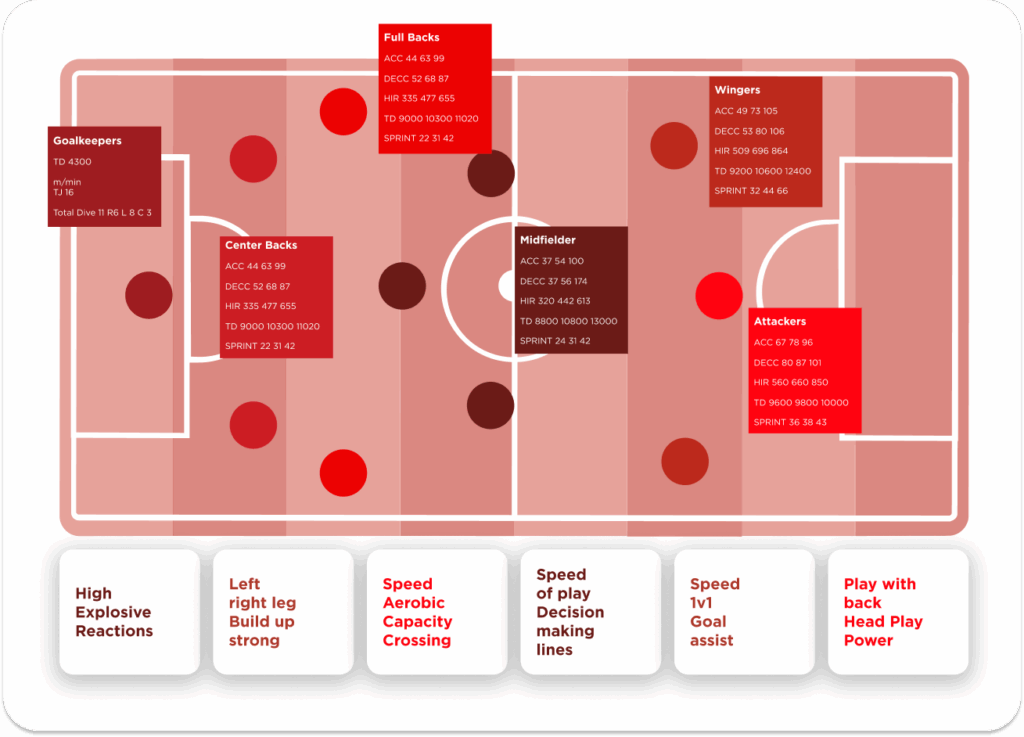
By using CI and EBI, we can:
- Identify force production vs. control imbalances
- Detect neuromuscular fatigue earlier
- Target interventions more precisely
The Quadrant Model Explained
In our model, each athlete’s CI and EBI values are compared against group averages. This creates four force strategy profiles:
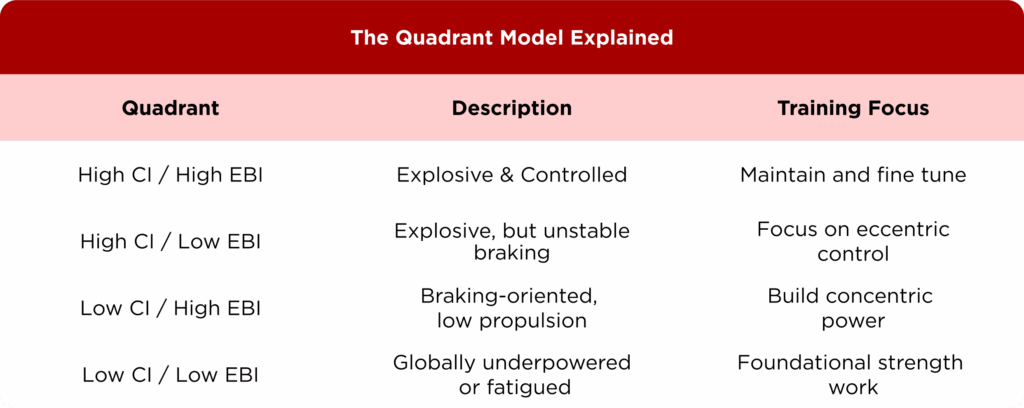
This framework allows for fast interpretation and guides individualized training pathways. As McMahon et al. (2014) show, CI and EBI are highly reliable markers when extracted from force plate systems under consistent conditions.
During preseason, we assessed senior players from a first-division professional football team using dual force plates (VALD ForceDecks). Each player performed two countermovement jumps (CMJ) with hands on hips, allowing us to capture Concentric Impulse (CI) – the area under the force-time curve during the upward phase – and Eccentric Braking Impulse (EBI) – the area under the curve during the braking phase.
Creating the Quadrants
We calculated team mean values for CI and EBI and used them as thresholds, dividing players into four quadrants:
- High CI / High EBI – well-rounded force and velocity capabilities
- High CI / Low EBI – strong propulsive ability, braking deficit
- Low CI / High EBI – strong braking capacity, low propulsion
- Low CI / Low EBI – both phases require development
Why This Matters
Looking only at the raw values shows where a player falls in the quadrants. However, linking these data with injury history i positional demands gives far more actionable insights. For example:
- A winger with low braking values but high velocities in 10m test might be at risk in high-speed decelerations.
- A central defender with low propulsion might struggle in aerial duels (don’t forget the context of the duel).
By identifying whether a player is lacking in the braking phase ili propulsive phase, we can refine exercise selection:
- Braking deficits → targeted eccentric overload, deceleration drills, and high braking impulse plyometrics
- Propulsion deficits → concentric emphasis lifts, loaded jumps, and maximal effort sprints
Now is a great time to have these tools to not only analyse the demands of each exercise, but also to see whether we can achieve better and faster adaptations through quadrant-based profiling and targeted exercise selection.
Visualizing Player Profiles
Below is the distribution of players based on their CI and EBI scores. Dashed lines represent team mean values for each metric.
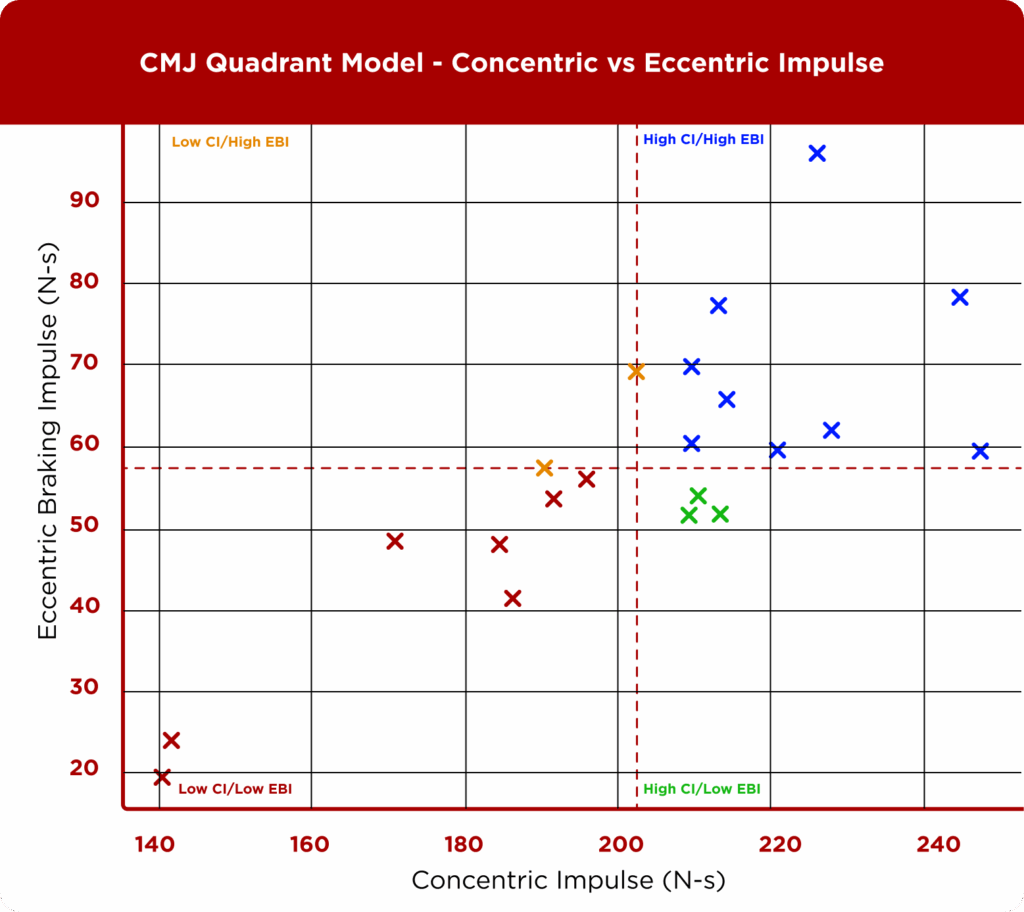
Key patterns emerged:
- Attackers often had high CI but low EBI — indicating explosive output with lower braking control
- Some defenders exhibited high EBI and low CI — capable of absorbing load, but lacking propulsion
- A minority fell into the low CI / low EBI quadrant, signaling overall neuromuscular suppression or fatigue
In our case, the data showed something important: 8 out of 26 players — around 31% — fell into the Low CI / Low EBI zone (red). This is the “danger” group, the outliers who have deficits in both propulsion and braking.
Players in this red zone might:
- Lack raw strength qualities in both eccentric and concentric phases
- Be less experienced or physically less developed
- Have a higher risk of fatigue-related drop-offs and performance inconsistency
We have already written a few times about how strength training in football is sometimes organised in a very repetitive, almost “copy-paste” manner — in a circuit format, always the same number of sets and reps, the same tempo, repeated for 20 weeks without significant change. While this might keep players “ticking over,” it often fails to address individual needs or specific neuromuscular qualities that can directly impact performance.
Strength training is far more than just doing 3×10 squats every week.
Example Program – Quadrant 2 Player (High Propulsive / Low Braking Ability)
For a player in Quadrant 2, our goal is to improve eccentric braking ability while maintaining high concentric output. Here’s a sample 4-week microdosed plan:
Weekly Wave Pattern (Sets per Day):
- Monday: 2 sets
- Tuesday: 1 set
- Wednesday: 3 sets
- Thursday: 1 set
Reps per Week:
- Week 1: 3 reps
- Week 2: 4 reps
- Week 3: 5 reps
- Week 4: Add weight and return to 3 reps
Other Parameters:
- Rest: 3 minutes between sets
- RIR: 3 (stop with 3 reps left in the tank)
Exercise Selection (3–5 key movements)
- Nordic Hamstring Curl – Slow eccentric phase (3–4 sec) to build hamstring braking strength.
- Trap Bar Deadlift from Deficit – Controlled lowering, 1s pause above the floor to reinforce force absorption.
- Drop Landing to Stick – Step off a 40–60 cm box, absorb the landing, stabilise instantly.
- Barbell Hip Thrust – Explosive concentric, controlled eccentric.
- Split Squat with Long Eccentric – 3–4 sec lowering, 1 sec pause at the bottom.
Why This Approach Works
- Targeted Adaptations: Exercises are chosen specifically to address braking deficits while maintaining propulsive ability.
- Load Management: Wave loading and microdosing avoid chronic fatigue and fit smoothly into football training schedules.
- Neuromuscular Freshness: Small but frequent doses keep players “primed” without compromising match readiness.
- Progressive Overload: Gradually increasing reps and then adding weight ensures long-term gains.
Weekly Microdosing Plan – Quadrant 2 Player
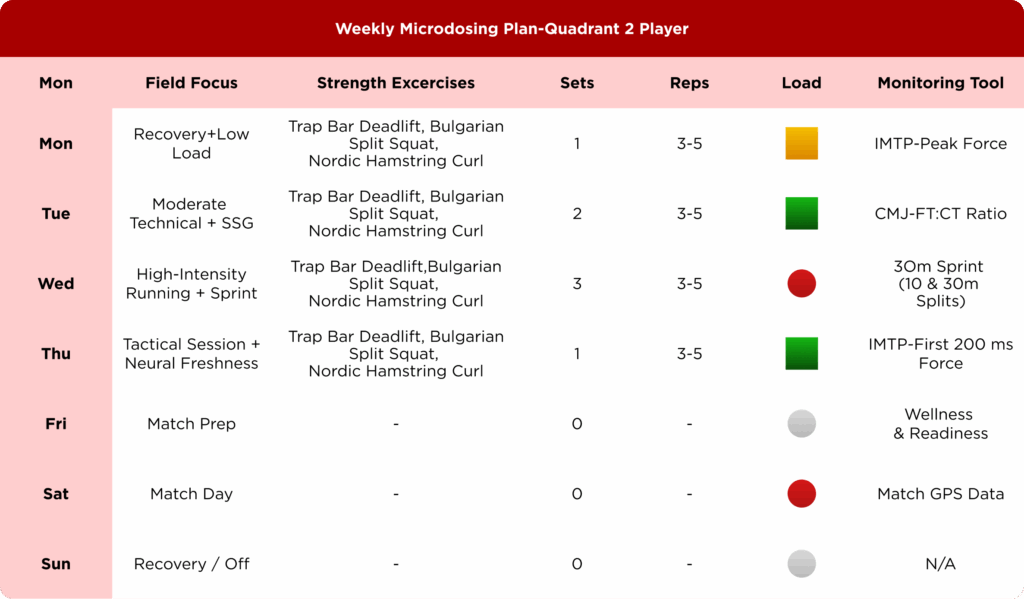
Zaključak
Force profiling through CI and EBI gives us a much deeper look at how players produce and control force — not just how much they can produce. By using the quadrant model, we’ve been able to quickly identify athletes who are excelling, those with targeted deficits, and a small but significant percentage (31%) who are lacking in both propulsion and braking qualities.
For these “red zone” players, traditional one-size-fits-all strength programs won’t cut it. Instead, by applying microdosing principles and tailoring exercise selection to their specific force strategy profile, we can address deficits more effectively while managing fatigue.
We can track whether interventions are working, adjust quickly, and avoid wasting valuable training time.
In the next article, we’ll take this approach one step further — interpreting another club’s values and comparing them against Premier League norms from the VALD Hub. This will give us a benchmark for where different competition levels stand in force strategy profiles, and where the gaps might be.
Reference
- Suchomel TJ, Nimphius S, Stone MH. The importance of muscular strength in athletic performance. Sports Med. 2016;46(10):1419–1449.
- Heishman AD, Curtis MA, Saliba E, Hornett RJ, Malin SK, Weltman AL. Comparing performance during morning vs. afternoon training sessions in intercollegiate soccer players. J Strength Cond Res. 2021;35(4):961–969.
- McMahon JJ, Rej S, Comfort P. Reliability of peak force, impulse, and RFD during isometric and dynamic tests of lower body function. J Strength Cond Res. 2014;28(10):2941–2948.



